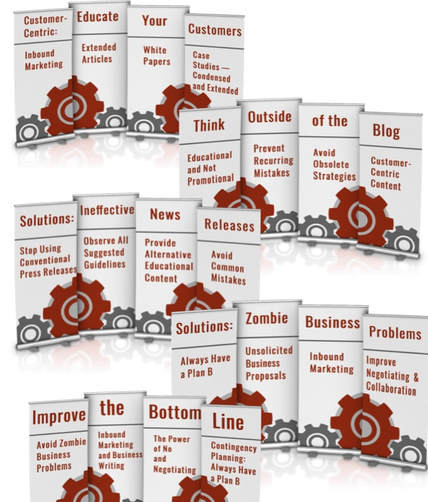Since work environments and business development campaigns often involve potential conflict, it seems appropriate to inject terminology usually reserved for military confrontations — rules of engagement. This military concept refers to guidelines for handling provocative actions by opposing forces. In extending the term to business applications, it is my intent to suggest a clearer path for making decisions about everyday issues such as blogs, business proposals, press releases, marketing and planning.
Defining and understanding key constraints and problems is a critical step in formulating workable business rules of engagement. My mission here is to introduce six terms that might be unfamiliar to some:
- Zombie Business Problems
- Textual Images
- Thinking Outside of the Blog
- Unsolicited Business Proposals
- Customer-Centric Content
- The Power of No
More details about each of these business concepts are provided below.
Zombie Problems
Perhaps the best way to explain Zombie Business Problems is by referring to challenges that continue to recur in organizations of all sizes. The “Zombie” descriptor is appropriate because these are problems that keep on coming back to haunt you. Regardless of what you choose to call these challenges, they will typically cause irreparable harm if allowed to continue unabated. Here is a SlideShare presentation that I produced about these special recurring problems:
Unique Textual Images
The changing landscape for both online and offline content presents serious challenges because an increasing number of readers scan articles rather than reading everything. While short videos and presentations can be effective in meeting this challenge, another viable alternative involves the use of textual images — showing relevant phrases instead of people or things. Two examples are provided within this article. The first one involves a GIF format that only works for online content; the second example is a collage of five separate textual images that I published. In addition to providing a visual communication opportunity, textual images allow users to include unique visual content rather than duplicate stock photo content.
Think Outside of the Blog
Business blogs continue to be misunderstood and misused by many. I believe that alternative content strategies will pay (much) higher dividends than a traditional blog post. Key examples include extended articles, case studies and white papers. I produced a series of presentations, articles and videos about Thinking Outside of the Blog — here is one of them:
Unsolicited Proposals
Business proposals are traditionally submitted in response to a formal RFP (Request for Proposal) process. But unsolicited proposals are often more effective (and successful) than those that are requested because of less competition. Instead of only using proposals for RFPs, seize the initiative and submit proposals to prospective clients without either a formal or informal request to do so.
Content That Is Customer-Centric
The “old-fashioned” way of selling goods and services is known as marketer-centric (also referred to as brand-centric) because marketers were typically in charge and insisted on controlling how and when consumers would receive information. Key examples of this outdated sales process are cold calling and traditional advertising. In contrast, today’s buyers increasingly insist on being in control and at the center of the sales process — hence customer-centric. This is exemplified by inbound marketing processes and educational content that is not promotional.
Using No (and Yes) More Effectively
“No is perhaps the most important and powerful word. Saying No the right way is crucial.” (William Ury)
The ability to use both “no” and “yes” effectively can be a challenge for even skilled negotiators and managers. If you need help in this area, William Ury has written a practical and useful trilogy — The Power of a Positive No, Getting Past No and Getting to Yes.
Two Common Themes for Business Rules of Engagement
The Bottom Line:
H2H (human to human) sales processes are frequently more successful than B2B (business to business) or B2C (business to consumer) sales processes. I consistently see two themes appearing in B2B, B2C and H2H scenarios:
- The importance of preventing or minimizing mistakes — especially recurring mistakes.
- The ongoing value of contingency planning — Always Have a Plan B.

